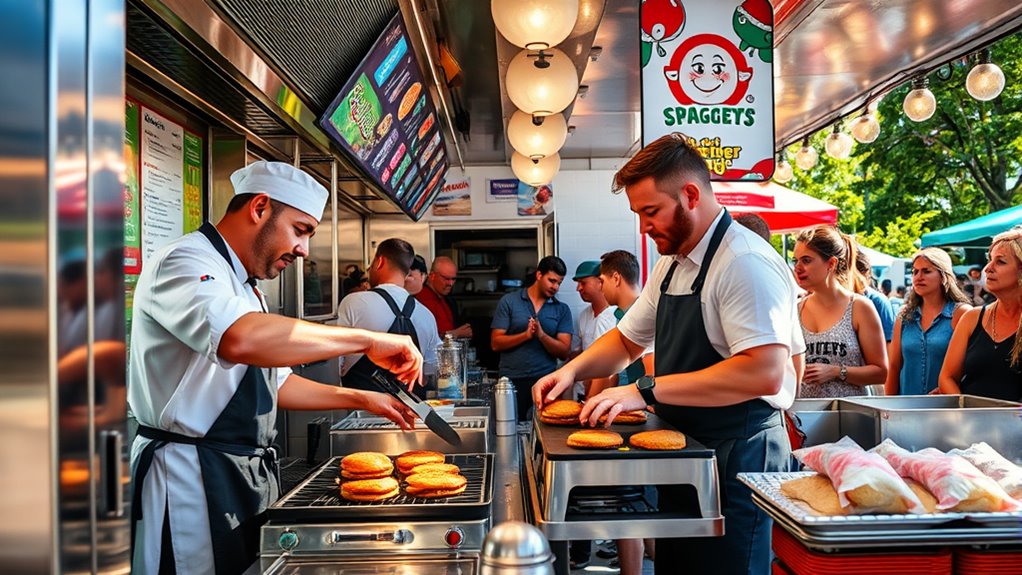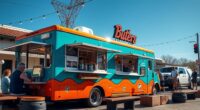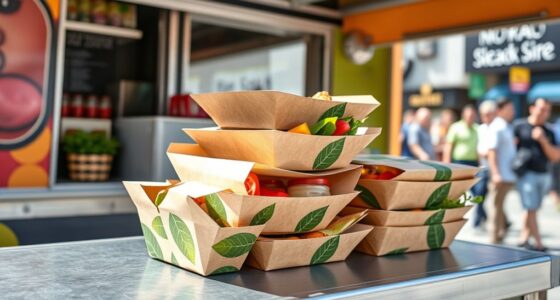To manage your food truck day-to-day, focus on optimizing your hours during peak times like lunch and dinner, using sales data and traffic patterns. Craft a simplified menu with high-margin items, and monitor sales to adjust offerings. Carefully control costs, reduce waste, and select busy locations or events that match your target market. Staying flexible with industry trends and seasonal changes helps keep your operation fresh. Explore these strategies further to boost your success.
Key Takeaways
- Optimize operating hours by focusing on peak times like lunch and dinner to maximize revenue and resource efficiency.
- Schedule staff based on sales data and customer traffic patterns, adjusting for seasonal and event-driven demand.
- Select high foot traffic locations aligned with target audiences and participate in events to boost visibility.
- Develop a simple, profitable menu with 5–12 items, focusing on high-margin, popular dishes and seasonal adjustments.
- Monitor sales, customer flow, and waste regularly to refine menu, pricing, and operational strategies for maximum profitability.
Optimizing Operating Hours for Maximum Customer Reach

To maximize customer reach, you need to carefully optimize your food truck’s operating hours around peak traffic times. Most food trucks see their busiest periods between 5 PM and 8 PM, with over 60% of operators reporting this as their peak evening window. Lunchtime from 11 AM to 2 PM also attracts high customer volume, according to over half of operators. Conversely, late-night hours from 11 PM to 2 AM tend to be slow, with only about 2% of peak activity. Seasonal or location-specific peaks may shift these times, so direct customer interactions can help you fine-tune your schedule. Focus your hours on these busy periods to maximize revenue and avoid overextending into slow times that drain resources. Adjusting hours based on real-time feedback guarantees you’re capturing the most customer traffic efficiently. Regular foot traffic assessment helps identify fluctuations and optimize your operating schedule accordingly, and integrating data-driven scheduling can further enhance your efficiency.
Crafting a Profitable and Efficient Menu

Creating a profitable and efficient menu starts with strategic planning around pricing, item selection, and operational flow. Set prices to achieve target gross profit margins of 7% to 15%, using formulas like Selling Price = COGS / (1 – desired profit margin). Keep menu prices 3 to 4 times ingredient costs, and use psychological pricing such as $2.99 to boost perceived value. Limit your menu to 5–12 items to streamline inventory, reduce waste, and ensure quick service. Focus on popular, high-margin dishes aligned with your concept, and rotate seasonal items to match customer demand. Source ingredients in bulk, prioritize versatile ingredients, and negotiate with suppliers. Design menu items for fast prep, with recipes that are simple and partly prepped, to optimize operational efficiency. Additionally, incorporating efficient layout and organized storage solutions can significantly improve workflow and reduce service times.
Monitoring Daily Sales and Customer Traffic
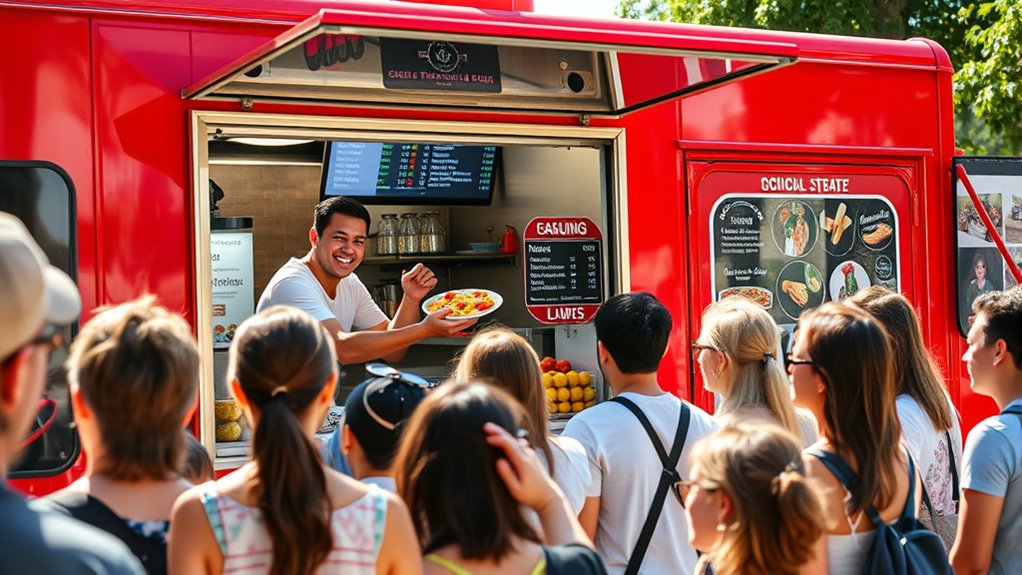
Tracking your daily sales and customer traffic helps you identify which items sell best and when your peak hours occur. By analyzing these trends, you can modify your menu, staffing, and inventory to maximize sales and efficiency. Staying on top of these metrics ensures you’re responding quickly to changing demand and maintaining profitability. Consistent tracking allows you to spot patterns early and adjust your operations accordingly.
Track Sales Trends
Have you ever wondered how food truck operators stay ahead of sales patterns and customer demands? Tracking sales trends is essential for this. Use your POS system to monitor key metrics like daily sales volume, total income, and the number of each menu item sold. These insights reveal what’s popular and what needs adjustment. Keep an eye on customer traffic numbers to estimate demand and identify high-traffic locations. Comparing sales data across days helps you spot patterns and plan for busy periods. Additionally, tracking missed sales days due to weather or logistics gives a clearer revenue picture. Regularly analyzing these metrics allows you to refine your menu, optimize pricing, and make informed decisions that boost profitability and customer satisfaction. Accurate data collection is crucial for making strategic decisions and staying competitive in the food truck industry. Monitoring indoor air quality can also be beneficial for maintaining a comfortable environment in your food truck, especially in urban areas.
Analyze Peak Hours
Understanding when your customers are most active is essential for maximizing sales and efficiency. By analyzing customer traffic and sales data, you can pinpoint peak hours and optimize your operations. Focus on the typical busy periods, such as:
- Evening (5 PM–8 PM), which about 63.6% of operators report as their busiest.
- Lunchtime (11 AM–2 PM), favored by 55.7% for peak sales.
- Late-night hours (11 PM–2 AM), which only 2.3% experience as busy.
- Variable or seasonal peaks influenced by location or season.
- Shifts in traffic patterns during weekends or special events.
- French fries or potatoes are the most popular menu items, making them a good indicator of customer preferences during peak times. Use real-time sales figures, social media feedback, and customer surveys to gather insights. Additionally, tracking traffic patterns can help identify emerging trends and adjust your schedule accordingly. Deploy location analytics when operating at multiple spots to understand local traffic trends and adjust your schedule accordingly.
Monitor Ticket Size
Monitoring your ticket size daily is essential to gauge how much each customer spends and identify spending patterns. By tracking this, you can see how menu items influence sales and spot shifts in customer behavior. Larger ticket sizes often come from upselling or offering higher-margin items like drinks or snacks. Consistent monitoring helps you manage inventory and cash flow more accurately, predicting sales volume and revenue. Your POS system provides real-time data, making it easy to calculate daily ticket averages and identify trends. If ticket sizes drop despite steady customer traffic, it signals potential issues with your menu or pricing. Regular review of ticket size alongside customer traffic helps optimize staffing, adjust marketing strategies, and ensure your pricing and menu selections maximize profitability. Incorporating dynamic pricing strategies can further enhance revenue by adjusting prices based on demand and time of day.
Managing Operational Expenses and Vehicle Maintenance
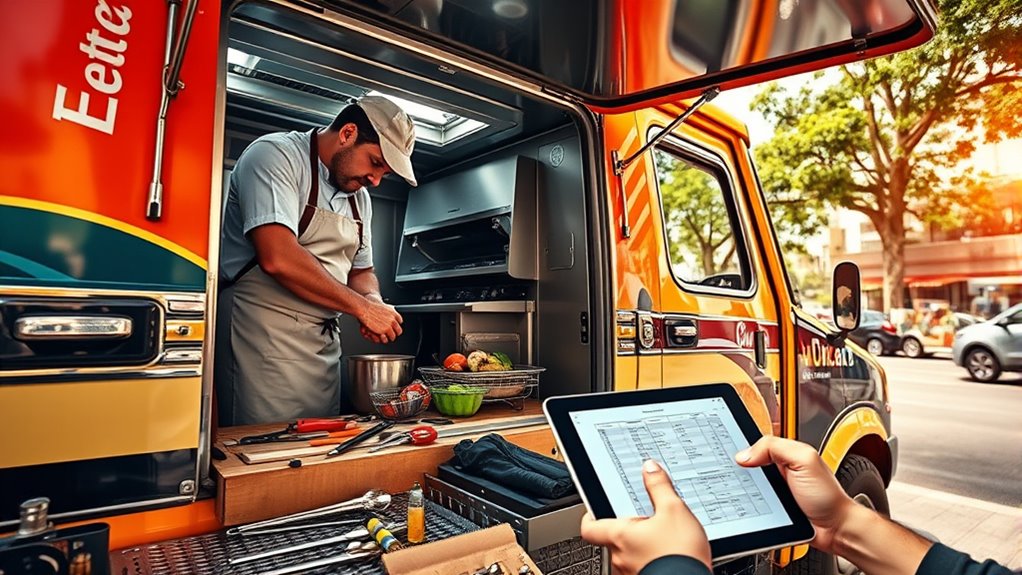
Effectively managing operational expenses and vehicle maintenance is essential for keeping your food truck profitable. You need to control costs like fuel, repairs, wages, and licensing to maximize profit margins. Regular vehicle inspections, oil changes, brake checks, and cooling system upkeep prevent costly breakdowns. Choosing fuel-efficient, reliable vehicles or electric conversions can lower fuel and maintenance expenses long-term. Keep a close eye on fuel costs, which can range from $125 to $1,000 monthly, depending on mileage. Budget for permits, licensing, and insurance, which can total $450 to $3,000 monthly. Negotiating shared kitchen space and employing efficient scheduling reduces overhead. Consistent maintenance and smart vendor negotiations help ensure your expenses stay manageable and your truck runs smoothly. Additionally, understanding the contrast ratio of your vehicle’s lighting can improve visibility during late-night operations, ensuring safety and efficiency.
Implementing Effective Marketing and Customer Engagement Strategies

To boost your food truck’s visibility and sales, implementing targeted marketing and customer engagement strategies is essential. Social media is a powerful tool—about 68% of food trucks use it regularly, with Facebook being the top platform, used by 75%. These campaigns can boost sales by roughly 20%, and active engagement encourages customers to spend 15% more. Mobile apps for locating trucks have increased downloads by 35%, making it easier for customers to find you. Participating in local events and festivals also expands your reach, builds community ties, and creates opportunities for direct feedback. Additionally, loyalty programs and email marketing foster repeat business, with over half of trucks adopting such strategies. Leveraging data analytics and understanding your target demographics help you refine your messaging and maximize your marketing efforts effectively. Customer engagement and loyalty programs are critical components, with 80% of food trucks participating in at least three festivals or events annually to enhance brand visibility. Using Email Marketing tools with advanced segmentation techniques can significantly improve your outreach by delivering tailored messages to specific customer groups.
Scheduling Staff to Match Peak Business Periods
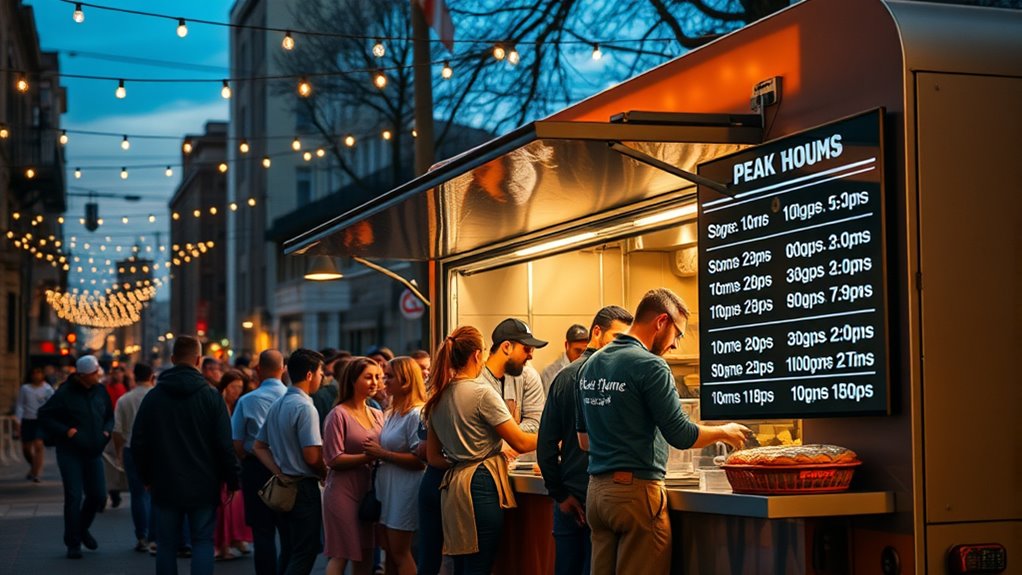
To effectively schedule staff, you need to identify your food truck’s peak operating hours by analyzing sales and customer traffic data. Once you know these busy times, you can align your staff schedules to guarantee adequate coverage. Regularly monitoring performance helps you make adjustments, keeping staffing efficient during high-demand periods. Additionally, leveraging technology tools can help automate this process and provide real-time insights for better staffing decisions.
Identify Peak Operating Hours
Understanding your food truck’s peak operating hours is essential for scheduling staff efficiently and maximizing sales. Most food trucks see the highest customer traffic during evening hours (5 PM–8 PM), with about 63.6% reporting this as their busiest period. Lunchtime (11 AM–2 PM) also experiences significant demand, with 55.7% of operators noting it as a peak. Late-night hours (11 PM–2 AM) are generally slow, affecting only 2.3%. Seasonal or location-based factors can shift these times. To optimize staffing, consider:
- Focusing on lunch and dinner peak hours
- Monitoring customer foot traffic patterns
- Adjusting for special events or weather
- Using sales data to spot demand fluctuations
- Incorporating real-time customer feedback
- Analyzing seasonal trends can help anticipate demand changes throughout the year. Additionally, understanding market research allows you to better align your staffing with customer preferences and demand fluctuations.
Identifying these peak periods helps you align staffing and boost profitability.
Align Staff Schedules Accordingly
Once you’ve identified your food truck’s consistent busy periods, aligning staff schedules with these peak times guarantees smooth operations and maximizes sales. Establish regular shift patterns based on your data to create a predictable, stable schedule that reduces staff turnover and builds trust. Offering steady part-time or full-time hours gives employees peace of mind and enhances reliability. Avoid ad hoc scheduling, which can cause chaos and uncertainty. Adjust staffing for seasonal fluctuations and special events by collaborating with organizers and preparing specific rosters. Use a mix of shift types—fixed, rotating, split, or on-call—to meet demand efficiently. Prioritize staffing during high-demand periods by assigning skilled workers, honoring time-off requests, and communicating changes promptly. Leveraging scheduling software can help optimize shift assignments and improve team coordination, which is crucial for adapting to fluctuating customer demand and maintaining operational efficiency. Additionally, understanding the benefits of consistent staffing can help you make informed scheduling decisions that support your business stability.
Monitor Performance and Adjust
Monitoring your food truck’s performance during peak hours allows you to make informed staffing adjustments that improve service and profitability. By analyzing sales data, customer flow, and wait times, you can identify when demand hits its highest points and adjust staff accordingly. This prevents overstaffing during slow periods and under-staffing during busy times. To optimize staffing, consider these ideas:
- Increase staff during lunch (11 AM–2 PM) and dinner (5 PM–8 PM) peaks
- Reduce staffing on weekdays with lower traffic
- Flex schedules for weekends with high Saturday demand
- Use real-time social media insights for immediate adjustments
- Track customer wait times to ensure quick service
- Regularly review your performance metrics to identify trends and adjust staffing levels proactively
Controlling Food Costs and Reducing Waste

Are you effectively controlling food costs and minimizing waste to maximize your food truck’s profitability? Start by setting PAR levels to keep stock aligned with sales forecasts, avoiding overstock and spoilage. Use sales data to predict demand accurately, preventing shortages and excess ingredients. Build strong relationships with suppliers for better prices and payment terms, reducing ingredient costs. Utilize inventory management tools linked to POS systems to track usage and flag slow-moving or expired stock. Conduct regular audits to identify shrinkage and inefficiencies. Apply pricing strategies like food cost percentage pricing and dynamic menu adjustments to maintain margins. Implement portion control, FIFO rotation, and waste tracking to cut down on food waste. Train staff thoroughly and explore composting options to further reduce waste and costs.
Selecting Strategic Locations and Event Participation

Choosing the right locations and participating in events are crucial steps to boost your food truck’s visibility and sales. You need to target high foot traffic areas like office districts, parks, shopping centers, and tourist spots to maximize customer flow. Matching location demographics with your target audience improves marketing efficiency and conversion rates. Timing also matters; schedule during busy lunch hours or weekends, adjusting for location type. Conduct market research through surveys and social media to uncover local preferences. Consider proximity to colleges, tech hubs, or entertainment districts for specialized crowds. High foot traffic zones significantly increase the potential customer base and sales volume. Focus on high pedestrian zones with easy access. Match demographics to your menu and branding. Schedule during peak hours and popular events. Research local laws and permits beforehand. Collaborate with other vendors to reduce competition.
Analyzing Weekly and Monthly Performance Metrics
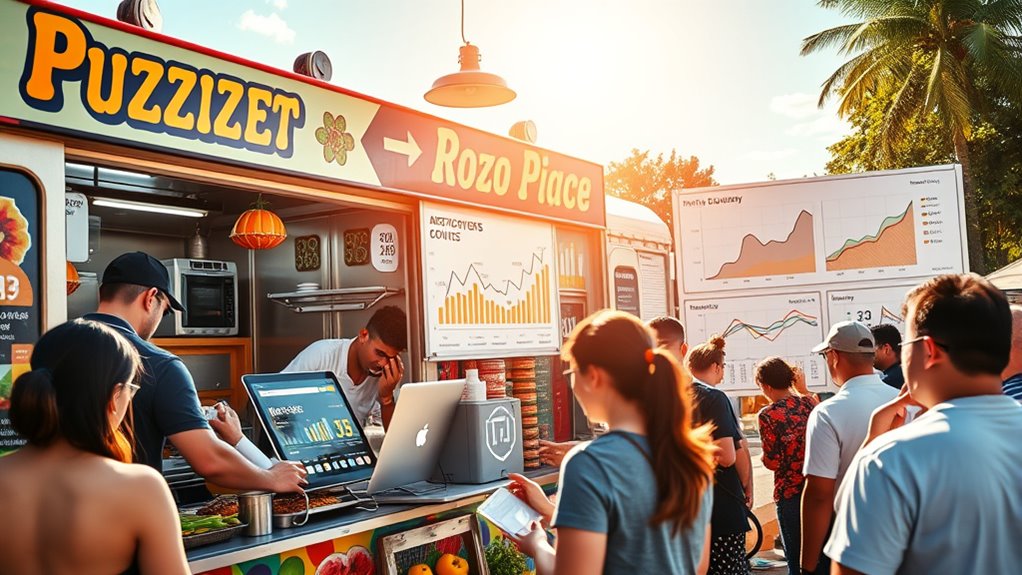
Analyzing weekly and monthly performance metrics provides vital insights into your food truck’s operations and financial health. Tracking key indicators helps you identify trends, optimize resources, and improve profitability. Use metrics like total sales revenue to monitor income trends and gross profit margin to evaluate food cost efficiency. Keep an eye on customer count and sales per head to understand demand and spending patterns. Review operational efficiency indicators such as labor cost percentage and waste reports to control costs. The table below highlights some crucial metrics:
| Metric | Frequency |
|---|---|
| Total Sales Revenue | Weekly/Monthly |
| Gross Profit Margin | Weekly/Monthly |
| Customer Count | Weekly |
| Waste Reports | Weekly |
| Sales per Labor Hour | Weekly |
Staying Adaptable to Industry Trends and Seasonal Changes
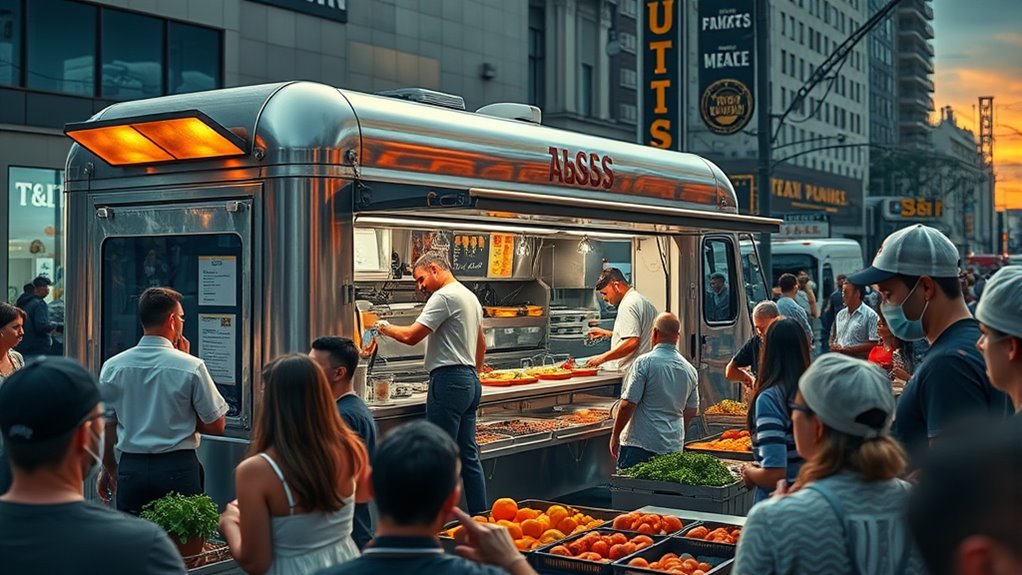
To stay competitive, you need to adjust your menu seasonally and keep an eye on industry shifts. This means updating ingredients, flavors, and offerings to match current trends and customer preferences. By doing so, you can maximize sales and build a loyal, trend-savvy customer base. Additionally, monitoring regional revenue variations can help you identify the most profitable locations and tailor your menu accordingly to capitalize on local demand regional revenue differences.
Adjust Menu Seasonally
Adjusting your menu seasonally is essential for staying relevant and meeting customer expectations. As weather and local events change, so should your offerings to keep customers engaged. In summer, add revitalizing items like iced drinks and salads to beat the heat. During cooler months, serve hearty dishes such as stews and grilled specials to attract more customers. Incorporate seasonal ingredients like berries or root vegetables to boost appeal. Leverage local influences by offering regional flavors aligned with tourist trends or cultural festivals. Use seasonal specials or limited-time offers to create urgency and encourage repeat visits. Additionally, adjust inventory to meet demand spikes, experiment with menu items, and stay flexible to capitalize on seasonal events and customer preferences.
- Add seasonal ingredients and flavors
- Introduce limited-time specials
- Adjust inventory for demand changes
- Incorporate regional and cultural influences
- Offer seasonal drinks and comfort foods
Track Industry Shifts
Staying responsive to industry trends and seasonal shifts keeps your food truck competitive and relevant. To do this, track changes like technological innovations, sustainability efforts, new event venues, evolving customer preferences, and market growth. Use tools like AI-powered management systems for predictive analytics and automated orders, and leverage geofencing to target specific events. Embrace eco-friendly packaging and renewable energy options to meet customer demand and regulations. Explore new venues such as pop-up spaces and ghost kitchens, and adapt menus for health trends and exotic flavors. Keep an eye on industry growth, which is projected to reach up to $4.36 billion by 2025 with a CAGR of 5–6.4%. Regularly monitoring these shifts helps you stay agile and capitalize on emerging opportunities.
| Industry Trend | Key Action | Impact |
|---|---|---|
| Tech & AI | Integrate AI & AR | Boost efficiency & sales |
| Sustainability | Use eco-friendly supplies | Appeal to eco-conscious customers |
| Event Venues | Expand into new spaces | Increase visibility & revenue |
| Consumer Preferences | Update menu options | Meet health & flavor trends |
| Market Growth | Track industry stats | Stay ahead of competition |
Frequently Asked Questions
How Do I Handle Fluctuations in Customer Traffic During Slow Days?
When customer traffic drops, you can boost sales by running targeted promotions like themed deals or flash discounts via SMS. Engage your community with events or special nights to attract more visitors. Adjust your menu for weather conditions and use real-time sales data to optimize pricing. Cross-train staff for flexibility, and leverage social media to keep customers informed and excited about your offerings on slow days.
What Are Best Practices for Managing Inventory to Prevent Shortages?
Think of your inventory as a delicate dance, where timing and balance keep everything in harmony. You should use real-time tracking to stay ahead of shortages, set par levels as your safety net, and conduct regular audits to catch discrepancies early. Build strong supplier relationships for flexible deliveries, and keep a close eye on stock and cash flow. This rhythm guarantees your food truck always hits the right note, no matter the demand.
How Can I Effectively Train Staff for Busy Service Periods?
To train staff effectively for busy service periods, you should use role-playing to simulate customer interactions and high-volume scenarios, helping them build confidence. Conduct hands-on practice with real tasks like order prep and cash handling, and do mock runs to identify areas for improvement. Cross-train team members to increase flexibility, give ongoing feedback, and motivate with incentives. Clear communication and teamwork are essential for smooth, efficient service during peak times.
What Safety Protocols Are Essential for Food Truck Operations?
You need to prioritize safety protocols that cover food handling, fire prevention, and health regulations. Guarantee all staff are trained in proper food storage, preparation, and hygiene practices, and that certified managers oversee safety standards. Keep fire extinguishers accessible, conduct regular equipment checks, and establish emergency procedures. Comply with local health codes, obtain necessary permits, and maintain safe vehicle and waste disposal practices to protect both your team and customers.
How Do I Adapt Menus for Dietary Trends and Health-Conscious Customers?
To adapt your menu for dietary trends and health-conscious customers, you should incorporate plant-based proteins like Beyond Meat, clearly label gluten-free and allergen-friendly options, and use locally sourced, seasonal ingredients. Offer customizable meals to meet individual needs, highlight nutritional benefits, and leverage technology like AI analytics for insights. Promote these options on social media, participate in health-focused events, and gather customer feedback to keep your offerings aligned with evolving preferences.
Conclusion
By mastering these strategies, you turn your food truck into a rolling success story. Think of each day as a blank canvas, waiting for your touch to create vibrant customer experiences and steady profits. Stay flexible, adapt to trends, and keep your eyes on the horizon. With dedication and smart management, you’ll steer your food truck toward a future as bright and rolling as the city lights at dusk.
